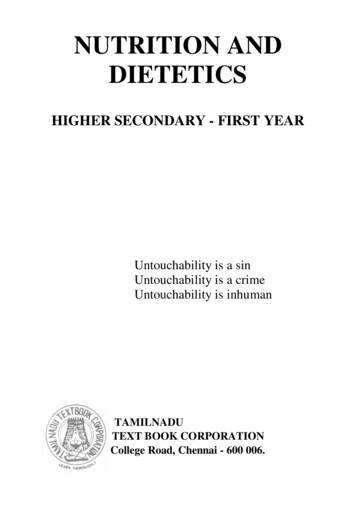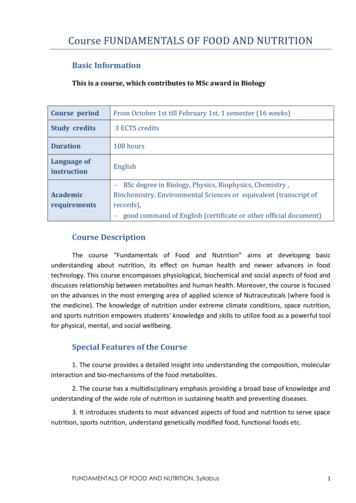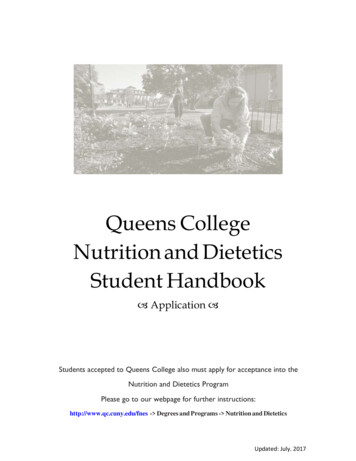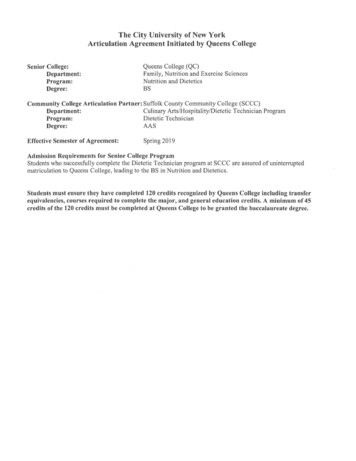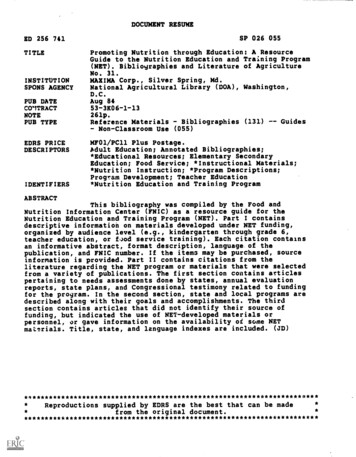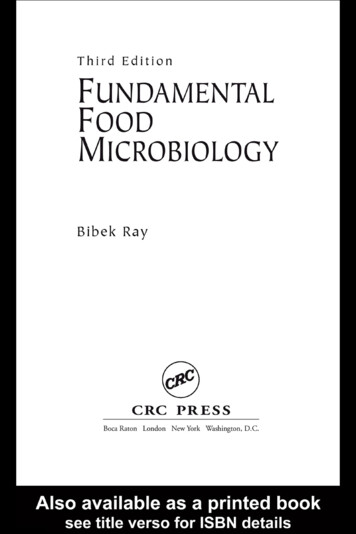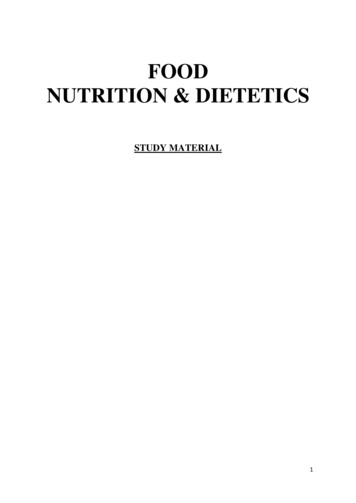
Transcription
FOODNUTRITION & DIETETICSSTUDY MATERIAL1
UNIT 1: CLINICAL AND THERAPEUTIC NUTRITIONLearning Objectives:After reading this unit, the students will be able to:1. define the terms dietetics, clinical nutrition, therapeutic diet and explain theconcept of diet planning in disease,2. enumerate the scope of dietetics and the role of dietitian in health care,3. explain the relationship between nutrition and infection,4. discuss the adaptation of normal diet to therapeutic diets, and5. describe the types of therapeutic modifications with respect to consistency,frequency of meals, methods of cooking etc,.Welcome to the study of clinical and therapeutic nutrition. Earlier youwere introduced to public health nutrition which you learnt focuses onhealth promotion and disease prevention in the general population.Clinical nutrition, on the other hand, as a study focuses on thenutritional management of individuals or group of individuals withestablished disease condition. Clinical nutrition deals with issues suchas altered nutritional requirements associated with the disease, diseaseseverity and malnutrition and many such issues about which we willlearn in this unit and other units in this course. Nutrition is an integralpart of the medical therapy as adequate nutrition support can go a longway in improving quality of care and improving patient's medicaloutcome. The importance of nutrition in the prevention of illness anddisease has been long recognized. Do you recall your grandma'shomemade remedies for common illnesses such as fevers, cough/cold,stomach ache, and indigestion or heart burn? Yes, nutritional care interms of providing hot cups of soup or porridge ensured that you wereadequately and appropriately nourished which helped improvemedical outcome. There is certainly more to clinical nutrition thanthis. So let us get to know about clinical and therapeutic nutrition.DIETETICS AND ROLE OF DIETITIAN IN HEALTH CAREAs a student of nutrition it must be evident to you by now that the dietand the food we eat have a direct and significant impact on our health.Eating a healthy balanced diet improves the quality of our life,2
whereas a poor diet may lead to morbidity and disease. The branch ofmedicine concerned with how food and nutrition affects human healthcomprising the rules to be followed for preventing, relieving or curingdisease by diet is called Dietetics. Dietetics deals with feedingindividuals based on the principles of nutrition. In fact, dietetics is thescience and art of human nutritional care.Clinical Dietetics is the application of dietetics in a hospital or healthcare institutional setting. Clinical dietetics focuses on individualnutrition support and symptom management. You may come acrossthe terms diet therapy, therapeutic diets while studying about clinicaldietetics. Let us get to understand these terminologies used in thecontext of dietetics.Diet therapy is a branch of dietetics concerned with the use of foodfor therapeutic purpose. Diet therapy is a broad term used for thepractical application of nutrition as a preventive or correctivetreatment of a disease. It concerns with recovery from illness bygiving good diet and prevention of disease. It may involve themodification of the existing dietary lifestyle to promote optimumhealth. For example a dietitian or a nutrition counselor may prescribea diet therapy to an obese person to improve health. The therapy mayinvolve including foods that improve the health condition whileavoiding foods (such as fats, sugars etc.) that may make the conditionworse. Basically the therapy promotes a balanced selection of foodsvital for good health. The principles of diet therapy are to: maintain good nutritional status, correct deficiencies or disease, if any, provide rest to the body, help metabolize the nutrients, and make changes in body weight, when necessary.Diet therapy may include prescribing specialized dietary regimes ormeal plans. These specialized diet regimens or meal plans are calledtherapeutic diets. Therapeutic diet refers to a meal plan that controlsthe intake of certain foods or nutrients. They are adaptation of thenormal, regular diet. Some common examples of therapeutic diets3
include clear liquid diet, diabetic diet, renal diet, gluten free diet, lowfat diet, high fibre diet etc. Therapeutic diets are usually prescribed bydietitians, nutritionists or physicians. We will learn about the types oftherapeutic diets later in this unit.Depending on the nature of the problem, a health care team mightinclude physician/doctor, nurses, nutritionists, dietitians, counselorsetc. But dietitian/nutritionists are at the forefront of nutritional care. Anutrition professional can advice, counsel, coordinates, educate,guide, inform, suggest and support. Nutrition professional works withindividuals/patients to help them understand that good nutrition andgood health go hand-in-hand. The various tasks and the role ofdietitian in health care are enumerated next.Role of Dietitian in Nutrition CareDietitian you know is an expert in dietetics, dealing with human nutritional care. A dietitian apply thescience and principals of human nutrition to help people understand the relationship between food andhealth and make appropriate dietary choices to attain and maintain health and to prevent and treatillness and disease.Dietitians work in a wide variety of roles in, for example, a clinical, public health or community, foodservice, administrative, freelance/consultancy, research or teaching capacity. However, you will findthat majority of dietitians are clinical dietitians working in hospitals, nursing homes and other healthcare facilities or specialized institutes/units to provide nutritional care to patients with a variety ofhealth conditions, and provide dietary consultations to patients and their families.The activities most likely to be undertaken by the clinical dietitians would include: Collecting, organizing and assessing data relating to health and nutritional status ofindividuals, groups and communities, Review and analyze patients nutritional needs and goals to make appropriate dietaryrecommendations, Develop and implement nutrition care plans and monitor, follow up and evaluate these plansand take corrective measures wherever required, Calculate nutritional value of food/meals planned, Prescribe therapeutic diets and special nutrition support and feeding regimens, Oversee the preparation of special diets, special nutrition formulas for patients who arecritically or terminally and require special feeding through oral, enteral or parenteral routes, Plan and prepare basic menus and assist in supervising food service personnel in preparing4menus and serving of meals, Schedule work assignments in the dietary unit to facilitate the effective operation of thekitchen and other food preparation or dining areas,
Therapeutic Diets: A ReviewRemember, a therapeutic diet is a qualitative/quantitative modifiedversion of a normal regular diet which has been tailored to suit thechanging nutritional needs of patient/individual and are used toimprove specific health/disease condition. It is a planned diet used tosupplement the medical or surgical treatment. Balanced diet is defined as onewhichcontains a variety of foods in suchquantities and proportions that the needfor energy, proteins, vitamins, minerals,fats and other nutrients is adequately metfor maintaining health and well being.Here you may enquire what a normal regular diet is.Normal diet, here, refers to a basic, balanced diet whichmeets the need of an individual.Refer to Figure 1.1 which illustrates routine hospital diets.5
Figure 1.1: Routine hospital dietsNormal or general diet in a hospital setting is a balanced diet whichmeets the nutritional needs of an individual/patient. It is given whenthe individual's medical condition does not warrant any specificmodification. Most hospitals follow simple dietary recommendations(given by ICMR for Indian population) while planning the generaldiet. It is planned keeping the basic food groups in mind so thatoptimum amount of all nutrients is provided. Further, since the patientis hospitalized or on bed rest, reduction of 10% in energy intakeshould be made. The diet provides approximately 1600 to 2200Kcal,and contain around 180 to 300g carbohydrates, 60 to 80g of fat and 40to 70 g of protein.Figure 1.1 also illustrates the soft diet and the liquid diets which areexamples of therapeutic diet. In addition to these there may be othermodified diets which individuals may require as part of theirtherapeutic needs. The reasons for modifying the diets may include: For essential or life saving treatment: For example in celiacdisease, providing gluten free diet, To replete patients who are malnourished because of diseasesuch as cancer and intestinal diseases by providing a greateramount of a nutrient such as protein, To correct deficiencies and maintain or restore optimumnutritional status,6
To provide rest or relieve an affected organ such as in gastritis, To adjust to the body's ability to digest, absorb, metabolize orexcrete: For example a low fat diet provided in fatmalabsorption, To adjust to tolerance of food intake. For example in case ofpatients with cancer of esophagus tube feeding is recommendedwhen patients cannot tolerate food by mouth, To exclude foods due to food allergies or food intolerance, To adjust to mechanical difficulties, for example for elderlypatients with denture problems, changing the texture/consistencyof food recommended due to problems with chewing and/orswallowing, To increase or decrease body weight/body composition whenrequired, for example as in the case of obesity or underweight, As helpful treatment, alternative or complementary to drugs, asin diabetes or in hypertensionThe significance of modified or therapeutic diet is that it is useful inmanaging the disease condition; it promotes resistance to diseasecondition and is preventive or supplemental treatment. To help youunderstand, consider this aspect. When an individual suffers from adisease, the disease process may cause the patient to lose appetite andtherefore eat less or in some other circumstances feel more hungryand eat more. Some individuals may have problems with digestion orabsorption of food or specific nutrient leading to changes in the typeof food which can be tolerated as also the frequency of feeding mayneed to be altered. Dietary modification than becomes a part of thetherapeutic demand. There are many types of dietary modifications. Achecklist of some common modifications is presented in the next subsection.Types of Dietary Adaptations for Therapeutic Needs7
A diet may need to be altered and adjusted in many ways before itmeets the therapeutic needs of an individual patient. Theseadaptations may include: Change in consistency of foods, such as liquid diet, soft diet,low fibre diet, high fibre diet. Increase or decrease in energy value of the diet such as lowcalorie diet for weight reduction, high calorie diet for burns. Increase or decrease in specific nutrients or type of foodconsumed, such as sodium restricted diet, lactose restricted diet,high fibre diet, high potassium diet. Elimination of spices and condiments, such as bland diets. Omission of specific foods such as allergy diets, gluten free diet. Adjustment in the ratio and balance of proteins, fats andcarbohydrate such as diabetic diet, renal diet and cholesterollowering diets. Test diets: These are single meals or diets lasting one or fewdays that are given to patients in connection with certain testse.g. the fat absorption test used to determine if steatorrhoea ispresent. Change in frequency of meals, feeding intervals, re-arrangementof the number and frequency of the meals such as diabetic diet,diet for peptic ulcer disease.Remember, normal nutrition is the foundation upon which thetherapeutic modifications are made. The various dietary adaptationsfor therapeutic needs are briefly highlighted here.A. Diets of Altered Consistency8
Therapeutic diets are modified for consistency, texture to fit thenutritional needs. Some individuals may require a clear liquid diet,while others a fully liquid diet or soft diet based on their medicalcondition. Figure 1.2 illustrates the modified diets based onconsistency.Figure 1.2: Modifications in consistencya) Liquid Diet consists of foods that can be served in liquid orstrained form in room temperature. They are usually prescribed infebrile states, postoperatively i.e. after surgery when the patient isunable to tolerate solid foods. It is also used for individuals with acuteinfections or digestive problems, to replace fluids lost by vomiting,diarrhoea. The two major types of liquid diets include - Clear liquiddiet and full liquid/fluid diet.i) Clear liquid diet provides foods and fluids that are clear and liquidat room temperature. The purpose of the clear liquid diet is to providefluids and electrolytes to prevent dehydration. It provides someamount of energy but very little amount of other nutrients. It is alsodeficient in fibre. Hence it is nutritionally inadequate and should beused only for short periods i.e. 1-2 days. An average clear liquid dietcontains 600 to 900Kcal, 120 to 200g carbohydrate, minimal fat 5 to10g protein and small amount of sodium and potassium (electrolytes).The clear liquid diet is usually useful in situations when thegastrointestinal tract has to be kept functionally at rest. It is alsoprescribed before and after certain types of surgery involving themouth or gastrointestinal tract. Also may be used in acute vomiting ordiarrhoea.Examples of clear liquid diet: Water, strained fruit juices, coconutwater, lime juice (nimbu pani), whey water, barley/arrowroot water,9
rice kanji, clear dal soup, strained vegetable or meat soup, tea orcoffee without milk or cream, carbonated beverages, ice pops, plaingelatin are some examples of clear liquid diet.ii) Full liquid diet provides food and fluids that are liquid or semiliquid at room temperature. It is used as a step between a clear liquiddiet and a regular diet. The purpose of the full liquid diet is to providean oral (by mouth) source of fluid for individuals who are incapableof chewing, swallowing or digesting solid food. It provides morecalories than the clear liquid diet and gives adequate nourishment,except that it is deficient in fibre. It is indicated for post operativepatients and for gastrointestinal illness. An average full liquid diet canprovide approximately 1000 to 1800 calories and 50 to 65g of proteinand adequate minerals and vitamins. The nutritive content of the fullliquid diet can be increased by using protein, vitamin and fibresupplements.Examples of full liquid diet: Foods allowed or included in a full liquiddiet include beverages, cream soups, vegetable soups, daal soups,strained food juices, lassi/butter milk, yougurt, hot cocoa, coffee/teawith milk, carbonated beverages, cereal porridges (refined cereals)custard, sherbet, gelatin, puddings, ice cream, eggnog, margarine,butter, cream (added to foods), poached, half boiled egg etc.b) Soft diet as the name suggests provides soft whole food that islightly seasoned and are similar to the regular diet . The term 'soft'refers to the fact that foods included in this type of diet are soft inconsistency, easy to chew and made of simple, easily digestible foods.It does not contain harsh fibre or strong flavours. It is given duringacute infections, certain gastrointestinal disorders and at the postoperative stage to individuals who are in the early phase of recoveryfollowing a surgery. The soft diet provides a transition between aliquid and a normal diet i.e. during the period when a patient has togive up a full liquid diet but is yet not able to tolerate a normal diet.Soft diet can be nutritionally adequate (providing approximately1800-2000 calories, 55-65g protein) provided the patient is able toconsume adequate amount of food.10
Examples of soft diet: A soft diet freely permits the use of cookedvegetables, soft raw fruits without seeds, broths and all soups, washedpulses in the form of soups and in combination of cereals andvegetables (like khichri, dalia), breads and ready-to-eat cereals (mostpreferable refined such as poha, upma, pasta, noodles etc.), milk andmilk beverages, yogurt, light desserts (including kheer, halwa,custard, jelly, ice cream), Egg and tender and minced, ground, stewedmeat and meat products, fat like butter, cream, vegetable oil and saltand sugar in moderation. Foods to be best avoided in the soft dietinclude coarse cereals, spicy highly seasoned and fried foods, dryfruits and nuts, rich desserts.Among the soft diet is also the mechanical soft diet also known as thedental diet which is a normal diet that is modified only in texture forease of mastication i.e. chewing. When an individual cannot chew oruse facial muscles for a variety of dental, medical or surgicalconditions mechanical soft diet is recommended. Elderly persons whohave dental problems are prescribed mechanical soft diets. The foodin mechanical soft diet is similar to the soft diet and may be fullliquid, chopped, pureed or regular food with soft consistency. Simplesalads, fruit salads and cottage cheese may be included. No food isrestricted unlike in the case of the customary soft diet. Just removingthe skin and seeds, cutting or chopping the food into small fine piecesare processes usually employed.c. Bland Diet: A bland diet is made of foods that are soft, not veryspicy and low in fiber. It consists of foods which are mechanically,chemically and thermally non-irritating i.e. are least likely to irritatethe gastrointestinal tract. Individuals suffering from gastric orduodenal ulcers, gastriris or ulcerative colitis are prescribed this diet.Foods Included: Milk and milk products low in fat or fat free; Bread,pasta made from refined cereals, rice; cooked fruits and vegetableswithout peel and seeds; Eggs and lean tender meat such as fish,poultry that are steamed, baked or grilled; Cream, butter; Puddingsand custards, clear soups.Foods Avoided: Fried, fatty foods; Strong flavoured foods; Strong tea,coffee, alcoholic beverages, condiments and spices; High fiber foods;hot soups and beverages; whole grains rich in fiber; strong cheeses.11
B. Modification in QuantityDepending on the clinical condition some individuals may require arestriction diet such as sodium restricted diet (as in high bloodpressure), purine restricted diet (as in gout) or low residue diet(prescribed and/or before abdominal surgery) designed to reduce thefrequency and volume of fecal output. Sometimes a completeelimination diet may be recommended when there is food intolerancesor complete insensitivity to a particular food such as a gluten free dietor a dairy free diet or nut free diet etc. Occasionally an increase in theamount of a specific dietary constituent may be prescribed such as ahigh potassium diet or a high fibre diet (as in constipation) or an ironrich diet (as in anaemia) when the clinical condition demands.C. Modification in Nutrient (Proteins, Fat, Carbohydrate) ContentThe nutrient content of the diet is modified to treat deficiencies,change body weight or control diseases such as hypertension ordiabetes. You may have come across patients with high blood sugarlevels, being prescribed a diabetic diet which requires changes in thequantity and type of carbohydrates included in each meal. Refinedcarbohydrates (such as sugar, honey, refined flour, semolina etc.) arebest avoided and use of complex carbohydrates (whole wheat flour,coarse cereals etc.) recommended. Patients with heart diseases requirea fat controlled low cholesterol diet while patients with renal (kidney)failure and advanced liver diseases a low protein diet, patients withHIV disease, cancer or malnourished a high protein, high calorie diet.Others as in the case of overweight, obesity a weight reduction diet,low in fat and calories.D. Changes in Meal FrequencyIndividuals suffering with gastro-esophageal reflux disease (GERD)stand to benefit by consuming small but frequent meals. 5 to 6 smallmeals instead of three regular meals are recommended.E. Changes in Method of CookingLeaching is indicated for cooking vegetables for people with chronickidney diseases because the kidney's no longer maintain the ideal12
level of potassium necessary for optimum health. Leaching (soakingin water) drains out excessive potassium and phosphorous from thevegetables. In elderly people food may be modified by mechanicalprocessing such as mashing, blendrizing or chopping. For patients onbland diet foods steamed, baked or grilled are recommended. Areview on the methods of cooking is presented for your understandingat the end of the book.F. Modification in the Method of FeedingTo provide adequate nutrition, normally oral feeding (by mouth) isrecommended. Sometimes oral feeding is not possible, under suchcircumstances special feeding methods such as enteral feeding(provision of liquid formula diet delivered via nasogastric feedingtube) and parenteral feeding (fluids containing water, glucose, aminoacids, minerals, vitamins given through the peripheral and centralveins) is recommended.Here we have just introduced to you some common dietarymodifications. A detail review on modified therapeutic diets indifferent disease conditions will be presented later in the units.13
UNIT 2: DIET IN HEALTH AND DISEASE :NUTRITION AND INFECTIONLearning Objectives:After reading this unit, the students will be able to:6. discuss the interaction between nutrition and infection,7. describe the effect of infection on nutritional status,8. discuss how malnutrition can lead to infection,The role of nutrition in disease prevention and healthmanagement is well established. Also you are aware that poornutrition can lead to ill health, disease and infections.Infections are caused by microorganisms which in turn canlead to malnutrition. Is there a link between these twoconditions? In this section we shall discuss the interaction ofinfection and nutrition.Infection and malnutrition have always been intricatelylinked. Evidence suggests that common childhood infectionsexert their influence in precipitating malnutrition. Therelationship between malnutrition, impaired immunity andinfection can be described as a vicious cycle. We will learnabout this vicious cycle in this unit.THE CYCLE OF MALNUTRITION AND INFECTION14
Malnutrition, as you already know, is an impairment of healthresulting from a deficiency or lack of food/nutrients orimbalance of nutrients in the diet. Almost any nutrientdeficiency, if sufficiently severe, will impair resistance toinfection. Figure 1 illustrates this concept.Let us understand this interaction between malnutrition andinfection with the help of a case study. Raju, a 4 year old boy,is suffering from infectious diarrhoea, caused by the invasionof the body by harmful microorganisms. The infection causedloose motion, fever, dehydration and impaired absorption. Onfurther investigation he was also found to be suffering fromprotein energy malnutrition reflecting as loss of weight. Now,when these two diseases exist in the same person (here Raju)concurrently, the interaction between the two diseases usuallyalters the nature, behaviour of the diseases. The overallclinical status of the child worsens often resulting in increasedcomplications or increased duration of the disease and in somecases results in death. In case of Raju, infection is a commonprecipitating factor for malnutrition. Ironically, malnutrition isalso a major factor in the occurrence of infection and the twointeract, making each other worse. Figure 1 illustrates thisinteraction.Figure 1: Interaction between infection and malnutrition15
An inadequate dietary intake, in case of Raju, led to weightloss, lowered immunity, mucosal injury, invasion bypathogens, and impaired growth and development ashighlighted in Figure 2. Raju's nutrition was furtheraggravated by diarrhea, malabsorption, loss of appetite,diversion of nutrients for the immune response, and urinarynitrogen loss, all of which lead to nutrient losses and furtherdamage to defense mechanisms making him more susceptibleto infections. This in turn led to further reduced dietary intakecausing a vicious cycle of malnutrition and infection ashighlighted in Figure 1.Figure 2: The vicious cycle of malnutrition and infectionSo when infection aggravates malnutrition or malnutritionlowers resistance to infection, the relationship between thetwo can be described as Synergism i.e. the simultaneouspresence of malnutrition and infection results in an interactionthat is more serious for the individual than would be expectedfrom the combined effect of the two working independently.The synergistic effect of malnutrition and infection often leadsto a high rate of child deaths in poor households/communitiesin India. What generally happens is that in a poor rural/slumhousehold a child is as such born with low birth weight (that16
is less than 2.5kg) because of inadequate dietary intake of themother during pregnancy. Subsequently the child is solelybreast fed for long periods (2 or more years). Complementaryfeeding (i.e. introduction of additional foods other than breastmilk) is delayed beyond 6 months of age. This triggers growthfaltering that is the child's growth and development slowsdown resulting in weight loss. In other terms malnutrition setsin. Moreover, in view of the poor environment and lack ofhygiene so common in rural/slum areas, the children arefurther exposed to infections like diarrhoea and respiratorytract infections. There is reduction in food intake by the childdue to loss of appetite due to these infections. As a result thereis further slowing down of growth. The cumulative effect ofdietary deficit and infection produces retardation of physicalgrowth leading to stunting (short stature or low height/lengthfor age as compared to normal child) in children. It isimportant to highlight here that the effects of stunting are longlasting. Children who are stunted grow up to be adults withreduced capacity to do physical work and are lesseconomically productive.From your understanding of the concept above now can yousummarize the effect of malnutrition on infection and thereciprocal relation i.e. the effect of infection on nutritionalstatus? Summarize the points in the space provided:Now check your responses with the summarized list presentednext. The basis of the effect is also described for yourunderstandingEffect of Malnutrition on Infection17
With reference to Figure 1 and 2, it must be evident to youthat inadequate nutrient intake lowers immunity. Also it leadsto mucosal damage. Let us get to know more on this aspect.a) Lowered Immunity: Immunity, in simple terms can bedescribed as the state of being unsusceptible or beingprotected against a particular disease or illness by the presenceof particular substance in the blood. These particular diseasefighting substances are called antibodies. A healthy wellnourished child/individual is at a lower risk of infection. Theycan fight the infection better. Why? Because of the ability ofthese well nourished individuals to produce these diseasefighting substances called antibodies.But in case ofmalnourished individuals there is reduction in antibodyproduction and therefore the disease fighting capacity islowered making the individual more prone to infections.Hence you would notice that children who are suffering fromspecific nutrient deficiencies such as protein energydeficiency or iron deficiency anaemia or vitamin A deficiencyare prone to infectionsb) Effect on the integrity of skin and mucous membrane:Dietary inadequacy diminishes resistance to infection byreducing the integrity of various tissues. In a healthy well fedindividual the skin, musosal membrane and other tissues arehealthy and prevent the entry of infectious agents. They act asa barrier and prevent the infection from entering the body. Inan individual suffering from malnutrition, the protectivemechanism is absent. The mucous membrane becomes readilypermeable and provides a favorable environment for thegrowth of the infectious agent. Consequently the individualwill catch infection easily.18
Next let us study about the effect of infection on thenutritional status.Infection and Nutritional StatusInfection, no matter how mild, has adverse effects onnutritional status. Nutritional status, as you may recall, refersto the condition of health of an individual as influenced by theutilization of the nutrients. So how does infection influencethe utilization of the nutrients which in turn influencesnutritional status? Let us understand. There can be multipleways but the first and foremost effect of infection is on loss ofappetite.a) Loss of Appetite: Do you recall the last time you were sickor down with some infection? What did you experience? Yes,you may not have been eager to consume food or were notable to tolerate food leading to loss of appetite. Further withuse of medicines such as antibiotics to treat the infection yourappetite may have been further affected leading to reducedfood intake. Now if this condition would have been prolongedit would have led to consistent decrease in food intake leadingto nutrient deficiency.b) Unfavorable cultural practices: One of the commonpractices in our country is to restrict or withdraw food fromindividuals when suffering from infection, particularlydiarrhoea or respiratory infections. It is believed that solidfoods, milk etc. be best avoided instead bland, starchy gruelslow in nutritive value be provided to rest the digestive system.Such a practice is deleterious; particularly when the individualdue to infection is already having low food intake and furtherreduction in the quality of diet contributes to nutrientdeficiencies and thus leading
1. define the terms dietetics, clinical nutrition, therapeutic diet and explain the concept of diet planning in disease, 2. enumerate the scope of dietetics and the role of dietitian in health care, 3. explain the relationship between nutrition and infection, . It is planned keeping the basic
